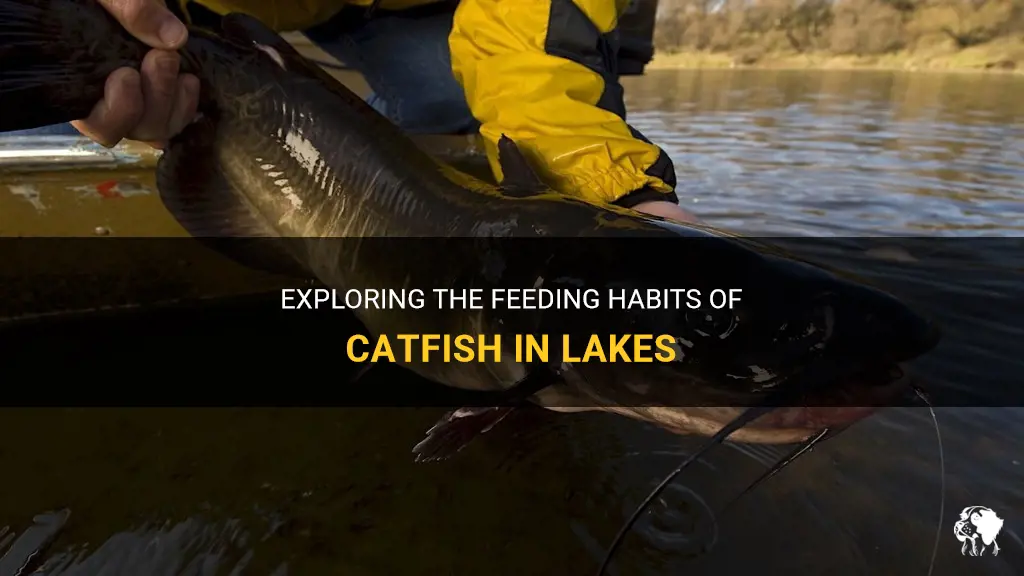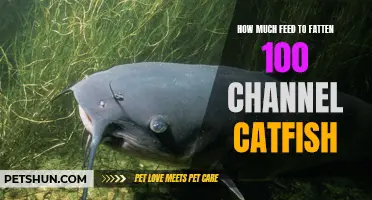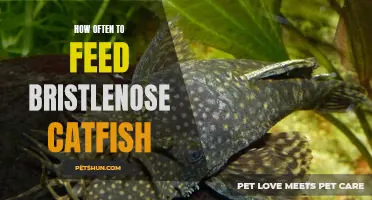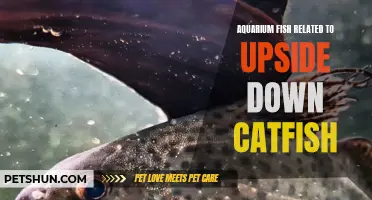
Have you ever wondered where catfish hide and feed in lakes? These elusive creatures have a knack for finding the perfect hiding spots and are known to be skilled hunters. In this article, we will explore the fascinating world of catfish and discover their preferred feeding grounds in lakes. So, grab your fishing gear and let's dive into the deep waters to uncover the secrets of where catfish feed in lakes.
| Characteristics | Values |
|---|---|
| Depth | Varies depending on species and time of year, but generally found in deeper water |
| Structure | Often found near submerged structures such as logs, stumps, and underwater brush |
| Bait | Prefers live bait such as worms, minnows, and small fish |
| Time of day | Most active at night, but can also feed during low-light conditions |
| Water temperature | Typically prefer warmer water between 70-85°F |
| Oxygen levels | Thrive in areas with good oxygenation, often near current or inflows |
| Bottom feeding | Feed primarily on the bottom, using their sensitive barbels to locate food |
| Prey | Eat a variety of prey including insects, crustaceans, small fish, and even small mammals |
| Feeding behavior | Opportunistic feeders that will scavenge for food and also actively hunt |
| Scent detection | Use their sense of smell to locate food, particularly when vision is limited |
| Feeding frequency | Can feed multiple times a day, or go without food for extended periods |
| Feeding season | Feed year-round, but feeding activity may increase during warmer months |
| Feeding patterns | Can be solitary feeders or form feeding aggregations, depending on species and conditions |
What You'll Learn
- Where do catfish typically feed in lakes?
- What types of areas do catfish prefer to feed in within a lake?
- Do catfish tend to stay in one location to feed, or do they move around?
- Are there specific depths where catfish are more likely to find food in lakes?
- What types of food sources do catfish commonly target in lake environments?

Where do catfish typically feed in lakes?
Catfish are bottom-dwelling fish that can be found in a variety of freshwater habitats, including lakes. When it comes to feeding habits, catfish are known for being opportunistic and adaptive. They have a diverse diet and will feed on a wide range of prey depending on the availability. However, there are certain areas in lakes where catfish are more likely to be found feeding.
Shallow Areas:
In the warmer months, catfish are commonly found in shallow areas of lakes where the water is warmer and there is abundant vegetation. These shallow areas provide a fertile hunting ground for catfish as they can find plenty of small fish, invertebrates, and aquatic insects to feed on. In particular, catfish like to hide among submerged logs, vegetation, and rocks in these areas as they wait for their prey to pass by.
Deep Areas:
During the colder months or when the water temperature is not ideal in shallow areas, catfish will often move to deeper parts of the lake. Deep areas provide a more stable and comfortable environment for catfish. They tend to feed on the bottom of the lake in these areas, using their sensitive barbels to locate prey and their powerful jaws to suck in food. Common prey include small fish, crayfish, snails, and worms.
Underwater Structures:
Catfish have a tendency to gather around underwater structures such as submerged trees, brush piles, and rock formations. These structures provide hiding places and attract smaller fish and invertebrates, which are key food sources for catfish. By positioning themselves near these structures, catfish can ambush their prey and easily catch them. Anglers often target these underwater structures when fishing for catfish.
Current Areas:
Catfish are known to congregate in areas where there is a strong current. The current brings in a steady supply of food, such as dead fish, insects, and organic matter, which catfish are quick to scavenge. These areas can be identified by the presence of debris and floating vegetation that get caught in the current. Catfish will position themselves near the bottom, facing into the current, to take advantage of any passing food.
It is important to note that the feeding habits of catfish can vary depending on the specific lake and its environmental conditions. Factors such as water temperature, oxygen levels, and the availability of food sources can influence where catfish choose to feed. It is always a good idea to do some research or consult local anglers to determine the best spots for catching catfish in a particular lake.
Caring for Honey Comb Catfish: A Complete Guide
You may want to see also

What types of areas do catfish prefer to feed in within a lake?
Catfish are known to be opportunistic feeders and can be found in a variety of areas within a lake. However, there are certain types of areas that catfish prefer to feed in, which can increase your chances of catching them. In this article, we will explore the different types of areas that catfish prefer to feed in and provide tips on how to target them in these areas.
- Deep Holes: One of the preferred areas for catfish to feed in within a lake is deep holes. Catfish are bottom feeders and tend to search for food in deep, dark areas. These holes can be found near drop-offs, submerged trees, or ledge systems. By using a fish finder or depth map, you can locate these deep holes and target them for catfish.
- Submerged Structures: Catfish are known to congregate around submerged structures such as fallen trees, brush piles, and rock formations. These structures provide cover for baitfish and other food sources, making them ideal hunting grounds for catfish. By casting near or on top of these structures, you increase your chances of enticing catfish to bite.
- Weed Beds: While catfish are primarily bottom feeders, they also feed near the surface, especially during the warmer months. Weed beds provide shade, cover, and a source of food for catfish. Crawfish, insects, and smaller baitfish often hide in weed beds, making them an attractive feeding ground for catfish. By casting near the edges or pockets of weed beds, you can entice catfish to strike.
- Creek Channels: Creek channels or underwater trenches are another type of area that catfish prefer to feed in. These channels provide a natural pathway for catfish to migrate and search for food. By targeting creek channels, you can increase your chances of intercepting catfish as they move along these pathways. Look for subtle depth changes or breaks in the bottom contour, as catfish often wait in these areas to ambush prey.
- Shallow Flats: Although catfish are primarily bottom feeders, they also forage in shallow flats, especially during low-light conditions. Shallow flats can be found near shorelines, especially in areas with rocky or gravel bottoms. Catfish use these flats to hunt for crayfish, worms, and other small invertebrates. By casting into these shallow flats, you can entice catfish to strike, especially during early morning or dusk.
When targeting catfish in these areas, it's important to use the right bait and presentation. Catfish have a keen sense of smell and are attracted to strong-smelling baits such as cut bait, chicken liver, or stinkbaits. You can also use live bait such as nightcrawlers, minnows, or crawfish to entice catfish to bite.
In conclusion, catfish can be found in various areas within a lake, but they do have preferences when it comes to feeding. Deep holes, submerged structures, weed beds, creek channels, and shallow flats are some of the types of areas that catfish prefer to feed in. By targeting these areas and using the right bait and presentation, you can increase your chances of catching catfish. Remember to check local regulations and obtain the necessary permits before fishing in any lake. Good luck and happy fishing!
The Ultimate Guide to Striped Raphael Catfish Care for Aquarists
You may want to see also

Do catfish tend to stay in one location to feed, or do they move around?
Catfish, members of the family Siluridae, are a diverse group of freshwater fish known for their distinctive whisker-like barbels. These barbels, which resemble cat whiskers, give the fish their name. Catfish are found in various habitats around the world, from fast-flowing rivers to slow-moving streams and lakes. One question frequently asked about catfish is whether they tend to stay in one location to feed or if they move around.
The feeding behavior of catfish can vary, depending on the species and the environment in which they live. Some catfish species are considered bottom feeders, meaning they primarily feed on food that has settled on the bottom of their environment. These catfish, such as the channel catfish (Ictalurus punctatus), are often found in rivers and lakes where they scavenge for food in the mud or sand. They use their barbels to locate prey and then suck it into their mouths.
Other catfish species are known to be more active predators, actively seeking out their prey in the water column. These catfish, such as the flathead catfish (Pylodictis olivaris), are often found in rivers and lakes where they hunt for smaller fish and other aquatic creatures. They have powerful jaws and teeth that they use to catch and consume their prey.
Catfish are known to be opportunistic feeders, meaning they will eat whatever food is readily available to them. They have a keen sense of smell and can detect the scent of food from a considerable distance. This ability allows them to locate food sources even when they are not in their immediate vicinity.
In terms of their movement while feeding, catfish can exhibit both stationary and mobile behavior. Bottom-feeding catfish, for example, may stay in one location for extended periods, relying on the currents and water movement to bring food to them. They may burrow into the sediment to find food or wait for food to come to them.
On the other hand, predatory catfish species are more likely to move around in search of food. They will actively swim and hunt, covering large areas in search of prey. These catfish have a strong and streamlined body shape that allows them to move efficiently through the water.
Experienced catfish anglers often use this knowledge of catfish feeding behavior to their advantage. They may choose to fish in areas where bottom-feeding catfish are known to congregate, such as near submerged structures or areas with a lot of debris. They may also use techniques like chumming, which involves dispersing bait or scent to attract catfish to a specific spot.
In conclusion, catfish feeding behavior can vary depending on the species and the environment. Some catfish are bottom feeders and tend to stay in one location to feed, relying on currents and water movement to bring food to them. Others are more active predators and will actively swim and hunt, covering large areas in search of prey. Understanding these behaviors can be helpful for those looking to fish for catfish or study their ecology.
The Ultimate Guide to Anchor Catfish Care for Beginners
You may want to see also

Are there specific depths where catfish are more likely to find food in lakes?
When it comes to fishing for catfish in lakes, understanding their feeding habits and preferred depths can greatly increase your chances of success. While catfish are opportunistic feeders and can be found throughout the water column, there are certain depths where they are more likely to find food.
Understanding Catfish Feeding Habits:
Catfish are bottom-dwelling fish and are primarily scavengers. They have a keen sense of smell and taste, guiding them to potential food sources. They are known to feed on a wide variety of prey, including insects, small fish, crustaceans, and even plant matter. Catfish are considered nocturnal feeders, preferring to feed at night when there is less activity and visibility.
Preferred Depths for Catfish Feeding:
While catfish can be found at various depths within a lake, certain depths tend to hold more food sources for them. In general, catfish are more likely to be found in deeper water during the day and move into shallower areas as night falls.
A. Shallow Areas:
During the warmer months, catfish can often be found in shallow areas near the shore. These areas provide access to a variety of food sources, including small fish and insects. When the water temperature rises, catfish will often venture into shallow areas to feed during the night.
B. Deep Water Drop-offs:
Deep water drop-offs, such as ledges and humps, are prime locations to find catfish. These structures provide easy access to their preferred food sources, as smaller fish and crustaceans often congregate around these areas. Additionally, deep water provides a cooler and more stable environment for catfish during the day.
C. River Channels and Creek Beds:
Catfish are often found near river channels and creek beds within lakes. These areas act as natural highways for food to flow into the lake, attracting catfish. River channels also provide deep and cooler water, which catfish prefer during the daylight hours.
D. Underwater Structures:
Catfish are known to seek cover and concealment within underwater structures such as fallen trees, submerged rocks, and brush piles. These structures create a sense of security for catfish and attract smaller fish and prey items. Fishing near or around these structures can increase your chances of hooking a catfish.
Conclusion:
While catfish can be found throughout a lake, understanding their feeding habits and preferred depths can significantly improve your fishing success. Shallow areas, deep water drop-offs, river channels, and underwater structures are all prime locations to target catfish. Keep in mind that these preferences may vary depending on the time of year, weather conditions, and lake characteristics. Experimenting with different depths and locations will help you dial in on the feeding patterns of catfish in your favorite lake.
The Complete Guide to Debauwi Catfish Care: Essential Tips and Advice for a Happy and Healthy Fish
You may want to see also

What types of food sources do catfish commonly target in lake environments?
When it comes to catfish, lake environments offer a wide variety of food sources for these bottom-dwelling fish. Catfish are opportunistic feeders and will consume anything that they can fit in their mouths. Their diet mainly consists of smaller fish, insects, crustaceans, and plant matter.
One of the primary food sources for catfish in lakes is small fish, particularly minnows and shad. These fish are abundant in lake environments and serve as a primary food source for catfish. Catfish have an excellent sense of smell and can detect the scent of injured or dying fish from a considerable distance. They will actively search for these injured fish to feed on.
In addition to small fish, catfish also target insects and crustaceans. They are known to feed on aquatic insects such as dragonfly nymphs, damselfly nymphs, and mayfly nymphs. Catfish will also consume crayfish, shrimp, and other small crustaceans that are found in lakes.
Plant matter also plays a role in the catfish diet. They will feed on algae, aquatic plants, and decaying plant material. This is especially true for catfish that inhabit shallow or weedy areas of the lake. These fish will root around in the vegetation, searching for insects and other small creatures that may be hiding among the plants.
Catfish have a unique feeding strategy called "benthic feeding." This means that they primarily feed on organisms that live on or near the bottom of the lake. They have specialized sensory organs called "whiskers" or barbels, which they use to locate food. These barbels are extremely sensitive to touch and help the catfish navigate and find food in dark or murky waters.
In terms of hunting behavior, catfish are most active during the night and in low-light conditions. They use their sense of smell and barbels to locate food, often patrolling the lake bottom in search of prey. Once they detect a potential food source, they will quickly pounce and engulf it with their large mouths.
In conclusion, catfish in lake environments target a variety of food sources including small fish, insects, crustaceans, and plant matter. They are opportunistic feeders and will consume anything that they can fit in their mouths. Their unique barbels and sense of smell help them locate and capture their prey, making them well-adapted to their lake habitat.
Feeding Frequency: The Key to Keeping Bristlenose Catfish Healthy
You may want to see also
Frequently asked questions
Catfish are bottom feeders and tend to spend much of their time near the lake bottom. They are known to inhabit areas with structure such as submerged trees, rocks, and submerged vegetation. These structures serve as hiding places for catfish and provide a source of food, as they attract smaller fish and insects.
Catfish are known to be opportunistic feeders and will feed during both day and night. However, they are more active during the twilight hours, such as early morning and late evening. During these times, catfish will actively search for food, using their excellent sense of smell and taste to locate prey.
Catfish have a diverse diet and will consume a wide range of food sources. They are primarily scavengers, feeding on dead or decaying organic matter, such as fish carcasses and rotting vegetation. Additionally, catfish will also eat live prey, including smaller fish, crayfish, worms, and insects.
Anglers can attract catfish to their fishing spot by using bait that appeals to their senses of smell and taste. Popular bait options for catfish include stink baits, chicken liver, worms, and blood bait. Additionally, creating an underwater feeding area by using a fish attractant or chumming with bait can also help lure catfish to a specific spot.
Catfish are often found near areas with a current or water flow, such as inlets or outlets of lakes, as these areas tend to concentrate food sources. Additionally, catfish may also feed near the mouths of tributaries, where there is a higher concentration of nutrients and prey. It is important to note that catfish can be found throughout the lake, and their preferred feeding spots can vary depending on factors such as water temperature, oxygen levels, and the availability of food.







